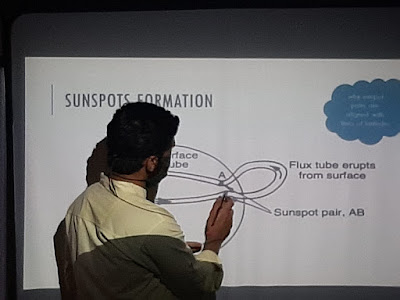The Ways of Magnetic Fields
The magnetic field of the earth has a dipolar structure, with its north magnetic pole close to the south geographic pole, and south magnetic pole close to the north geographic pole. Due to its dipolar structure, it was considered earlier that there may be a giant bar magnet inside the earth. But since the earth's magnetic field has been there for billions of years and the temperature inside the earth is very high that permanent magnetism cannot sustain there. Then in the early 20th-century dynamo theory came into the picture. The Dynamo theory explains how fluid flows of conducting fluid can sustain and intensify given the initial magnetic field inside a planet or a star like a sun.
Earlier it was thought that Earth's magnetic field only helps to
navigate, but it has to do a lot more than that. Earth's
magnetosphere has been protecting Earth's atmosphere and indirectly
all the life on earth from harmful radiation in the form of solar
winds. Also, the interaction of the magnetosphere with this solar
wind produces beautiful aurora near the Earth's poles. The very
interesting phenomenon; the reversal of Earth's magnetic field has
not been understood yet. Apart from The Earth Jupiter, Saturn,
Uranus, and Neptune are known to have their own magnetic field. Some
other planets and natural satellites were having their own magnetic
field which is not there today.
Finally,
our own star The Sun has its magnetic field which is very dynamic and
capricious. The sunspots were the earliest manifestations of the
magnetic field of the sun. This magnetic field is also maintained by
the dynamo action in the convection layer, but unlike the Earth's
case conducting fluids here is plasma not liquid metal. J.C.Maxwell
was the first to observe the relation between 11 solar cycles and
maximum disturbance of terrestrial magnetic fields. Sunspots are
formed near the equator where azimuthal fields are very intense and
these high-intensity magnetic fields suppress turbulent convective
motions towards the photosphere. Making the region cooler and hence
darker. Since the formation of sunspots is symmetric about the sun's
equator and the direction of magnetic flux changes over 11 years so
this 11-year solar cycle is related to the reversal of the azimuthal
magnetic field. Magnetic flux loops that produce sunspots rise above
the photosphere up to the corona layer of its atmosphere. The
magnetic field lines in this layer are under tremendous stretching
such that they frequently snap and rejoin, in between they release a
large amount of heat energy which raises the temperature of the
plasma in the corona level to 10^6K. This causes a reduction of
density so that solar wind is generated which travels through the
solar system spiraling around the sun with a velocity of a few
hundred kilometres per second.
Field of magnetohydrodynamics which studies all these and many more phenomenon related to astrophysics. But it has its own limitations, journey started nearly about a century ago has not yet come to an end. And still today researchers are working on dynamo theory to get ourselves closer to the reality.
The discussion went on covering magnetic fields of planets and its importance for atmosphere and ways of studying the magnetic fields of rocky and gaseous planets.







No comments:
Post a Comment